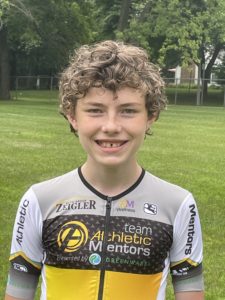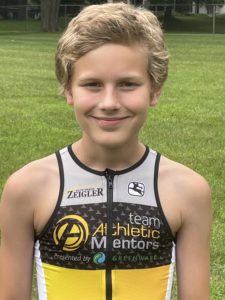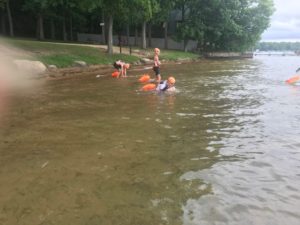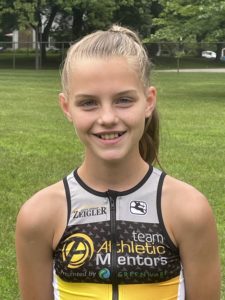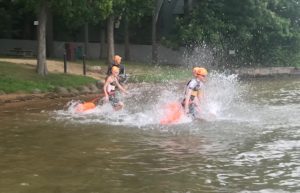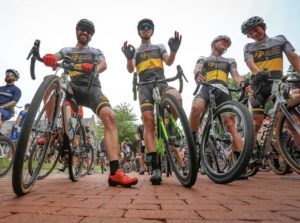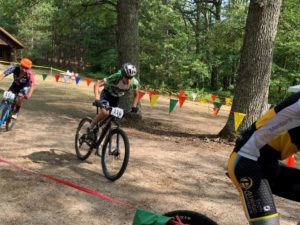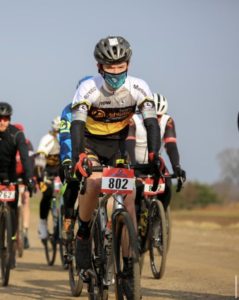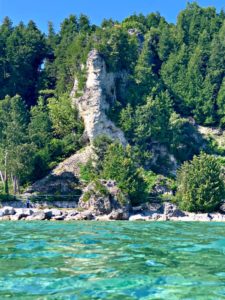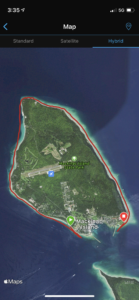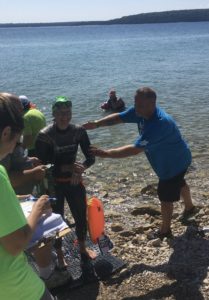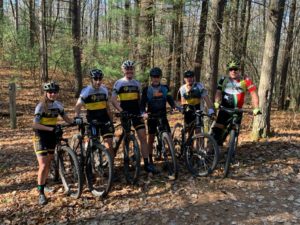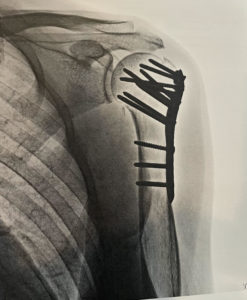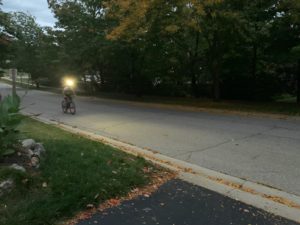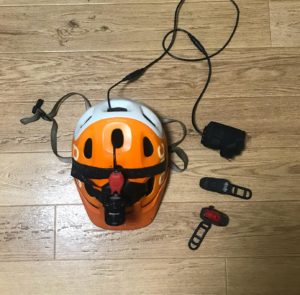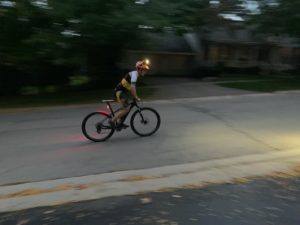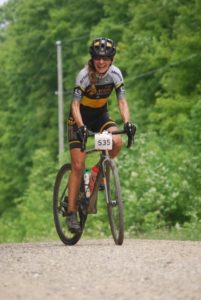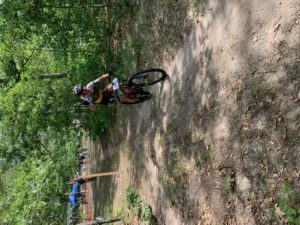By: Joel Bretzlaff
I’m a member of Athletic Mentors Junior Cycling Team. I participated in the Michigan Scholastic Cycling Association (MiSCA) is a youth-only race series that takes place in the fall, offering a variety of categories for racers in 1st-12th grade. They focus heavily on getting more kids on bikes, but also offer extremely competitive high school racing. This season I raced in the 9-10th grade category. I have been racing in MiSCA since 2016, and I always look forward to this chapter of my race season. For the MiSCA races, I race under Orange Krush Junior Race Team.
for racers in 1st-12th grade. They focus heavily on getting more kids on bikes, but also offer extremely competitive high school racing. This season I raced in the 9-10th grade category. I have been racing in MiSCA since 2016, and I always look forward to this chapter of my race season. For the MiSCA races, I race under Orange Krush Junior Race Team.
Race #1: Heritage Park – This year, the season opener took place at Heritage Park in Adrian, Michigan, on August 29th. The course was quite tight, and cornering was the most important skill to have. The first sprint start of the year is always the most hectic, and I rode into the fourth position as we entered the woods. I noticed that the leader was 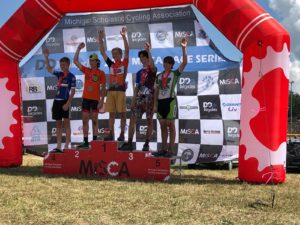 starting to open up a gap on the next two riders in front of me, so when we broke out onto a two-track climb, I seized my opportunity and passed the second and third riders. From here, I was able to get onto the wheel of the leader. We held a ~10 second gap for the first two miles of the race. Eventually, as we approached the longest climb of the course, I moved to the front and broke away from the pack. Over the remainder of the first lap, I extended my lead, which was over thirty seconds as we crossed through the start/finish area. Nothing changed over the second lap, where I pulled out another thirty seconds and took the win. This race taught me how to ride during a breakaway.
starting to open up a gap on the next two riders in front of me, so when we broke out onto a two-track climb, I seized my opportunity and passed the second and third riders. From here, I was able to get onto the wheel of the leader. We held a ~10 second gap for the first two miles of the race. Eventually, as we approached the longest climb of the course, I moved to the front and broke away from the pack. Over the remainder of the first lap, I extended my lead, which was over thirty seconds as we crossed through the start/finish area. Nothing changed over the second lap, where I pulled out another thirty seconds and took the win. This race taught me how to ride during a breakaway.
Race #2: Addison Oaks – On September 12th, MiSCA traveled to Addison Oaks, a wide open, fast course with many straightaways. I went into this race as the series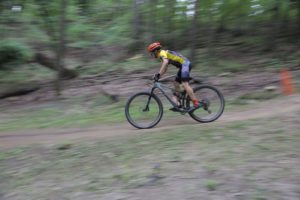 leader, and I led into the woods after the final sprint. On the first climb, I allowed someone to pass as I did not want to set the pace. I drafted the rider in front for much of the first lap, but as we reached a pavement section, two riders behind me powered around the leader and I and pushed the pace until we re-entered the woods. This placed me in fourth position, and I was doing everything I could to get around the two riders in front of me and get onto the leader, who was beginning to pull away. I got around one rider, but couldn’t get around the other until the grassy start/finish area. At this point, I was very worn out, and started to lose position as the race went on. I ended up with a fifth place finish and learned the importance of positioning, due to the amount of energy I used just to move up a couple positions in the trail.
leader, and I led into the woods after the final sprint. On the first climb, I allowed someone to pass as I did not want to set the pace. I drafted the rider in front for much of the first lap, but as we reached a pavement section, two riders behind me powered around the leader and I and pushed the pace until we re-entered the woods. This placed me in fourth position, and I was doing everything I could to get around the two riders in front of me and get onto the leader, who was beginning to pull away. I got around one rider, but couldn’t get around the other until the grassy start/finish area. At this point, I was very worn out, and started to lose position as the race went on. I ended up with a fifth place finish and learned the importance of positioning, due to the amount of energy I used just to move up a couple positions in the trail.
Race #3: Merrell Trail – One week later, we traveled to Grand Rapids to race at Merrell Trail, a race with long climbs and technical descents. Off the start line, I 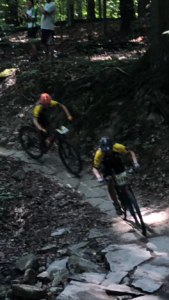 noticed that my drivetrain was skipping gears, so I dialed back my pace on the long, grassy opening section. I entered the woods in fourth position, and the leader was already pulling out a major gap on the first long climb. We quickly caught up to the rider in front. On a tricky corner, I slid out and nearly ran into a tree, but I got back to the leaders. The four of us started to open up a gap, then the first rider crashed and the other two and I got around him. Eventually, the leader started to pull away, and after some attempts, I moved into the second position and began to chase. When we came to Sawtooth, a ridiculously technical downhill section, I completely closed the gap. I rode the wheel of first place until we came to a long climb near the end of the lap, where I was dropped. As I came through the start/finish area, I was informed that I was behind by ten seconds. I worked to pull this back over the second lap, and completed this comeback on Sawtooth. The race came down to a sprint finish, but I wasn’t able to overtake my competitor, and was second by 0.4 seconds. I now know just how much of an advantage leading into a sprint can offer.
noticed that my drivetrain was skipping gears, so I dialed back my pace on the long, grassy opening section. I entered the woods in fourth position, and the leader was already pulling out a major gap on the first long climb. We quickly caught up to the rider in front. On a tricky corner, I slid out and nearly ran into a tree, but I got back to the leaders. The four of us started to open up a gap, then the first rider crashed and the other two and I got around him. Eventually, the leader started to pull away, and after some attempts, I moved into the second position and began to chase. When we came to Sawtooth, a ridiculously technical downhill section, I completely closed the gap. I rode the wheel of first place until we came to a long climb near the end of the lap, where I was dropped. As I came through the start/finish area, I was informed that I was behind by ten seconds. I worked to pull this back over the second lap, and completed this comeback on Sawtooth. The race came down to a sprint finish, but I wasn’t able to overtake my competitor, and was second by 0.4 seconds. I now know just how much of an advantage leading into a sprint can offer.
Race #4 Bloomer Park – With the Bloomer Park race quickly approaching, the rainfall was coming down hard. On September 26th, it was clear that the race conditions were going to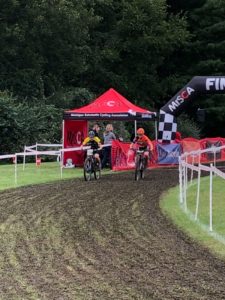 be a disaster. The start/finish area was a complete mud pit. Even though I struggled in the mud on the wholeshot, I led into the woods. One rider held onto my wheel, and third place was about 10 seconds back. When we came to Art’s Lungbuster, a four minute climbing segment early in the lap, I slid out in the mud after clipping a tree with my handlebar. I couldn’t clip in for a few seconds due to mud on my cleats, and by that time, the third place rider had already caught up to me. The two of us worked hard to close the gap to first, but it was clear that it was an impossible task. As we came through for our third lap, the rider I was with overtook me. I held his wheel for half a lap, but ended up slowing down and landing a third place finish. After this race, I further understood the importance of riding a clean race.
be a disaster. The start/finish area was a complete mud pit. Even though I struggled in the mud on the wholeshot, I led into the woods. One rider held onto my wheel, and third place was about 10 seconds back. When we came to Art’s Lungbuster, a four minute climbing segment early in the lap, I slid out in the mud after clipping a tree with my handlebar. I couldn’t clip in for a few seconds due to mud on my cleats, and by that time, the third place rider had already caught up to me. The two of us worked hard to close the gap to first, but it was clear that it was an impossible task. As we came through for our third lap, the rider I was with overtook me. I held his wheel for half a lap, but ended up slowing down and landing a third place finish. After this race, I further understood the importance of riding a clean race.
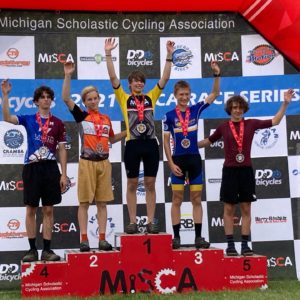 Race #5: Milford Trail Time Trial – The October 10th stop of the MiSCA season was a time trial this year due to trail and field limitations. Racers were sent in series standings order at fifteen second intervals. I pushed hard off the start line, trying to catch up to the rider in front of me. As the first lap went on, it was all I could do to keep them within my sights. I pushed on the second half of the lap, and came through the start/finish area with a six second lead. However, by this point, I was completely gassed and my pace slowed. I knew that my race was now about holding off the third place rider. As I broke out onto the final sprint, my teammates informed me that the race for second was close, and urged me to push it. I sprinted with all I had, and ended up 0.3 seconds ahead of third place. This race taught me that some days are not meant to be and that risking more positions to try and ride for a win is not always the best idea.
Race #5: Milford Trail Time Trial – The October 10th stop of the MiSCA season was a time trial this year due to trail and field limitations. Racers were sent in series standings order at fifteen second intervals. I pushed hard off the start line, trying to catch up to the rider in front of me. As the first lap went on, it was all I could do to keep them within my sights. I pushed on the second half of the lap, and came through the start/finish area with a six second lead. However, by this point, I was completely gassed and my pace slowed. I knew that my race was now about holding off the third place rider. As I broke out onto the final sprint, my teammates informed me that the race for second was close, and urged me to push it. I sprinted with all I had, and ended up 0.3 seconds ahead of third place. This race taught me that some days are not meant to be and that risking more positions to try and ride for a win is not always the best idea.
Race #6: Cannonsburg Ski Area State Championships – For the state championship race of the 2021 season, MiSCA selected Cannonsburg Ski Area. This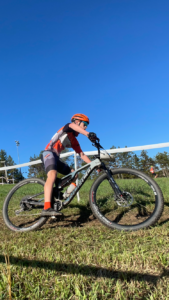 course is jam-packed with brutal climbing throughout the course. My category was only completing one lap, so my strategy was much different going in. Due to time restraints from camping the weekend of the race, I did not have an opportunity to warm up, but still fought my way into second position during the wholeshot. After five to ten minutes, I was finally feeling warmed up, and the pack was thinning out behind the leader and I. Two riders were still holding on, but one of them dropped off at one of the large climbs about twenty minutes into the race. I was in the middle of a pack of three as we continued to ascend our way around the ski hill. Nearing the final sprint, I almost went off the trail on the last corner, and lost about 1 second before we broke out of the woods. The end of the race included a 200 foot grassy climb straight up the hill, and wet, tight switchbacks all the way down. When the climb opened up, I made my move and overtook the race leader. I pulled with everything I had, but one racer was still on my wheel at the top of the climb. At one point during the descent as I was trying to recover for the very end of the race, I was almost overtaken, but I held onto my lead and took the final sprint. This race taught me the value of allowing another rider to control the race and sticking to a plan.
course is jam-packed with brutal climbing throughout the course. My category was only completing one lap, so my strategy was much different going in. Due to time restraints from camping the weekend of the race, I did not have an opportunity to warm up, but still fought my way into second position during the wholeshot. After five to ten minutes, I was finally feeling warmed up, and the pack was thinning out behind the leader and I. Two riders were still holding on, but one of them dropped off at one of the large climbs about twenty minutes into the race. I was in the middle of a pack of three as we continued to ascend our way around the ski hill. Nearing the final sprint, I almost went off the trail on the last corner, and lost about 1 second before we broke out of the woods. The end of the race included a 200 foot grassy climb straight up the hill, and wet, tight switchbacks all the way down. When the climb opened up, I made my move and overtook the race leader. I pulled with everything I had, but one racer was still on my wheel at the top of the climb. At one point during the descent as I was trying to recover for the very end of the race, I was almost overtaken, but I held onto my lead and took the final sprint. This race taught me the value of allowing another rider to control the race and sticking to a plan.
I finished the season with a second place in the series, and I can’t wait to race Varsity next year!
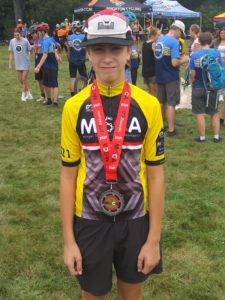 By: Elijah Garris
By: Elijah Garris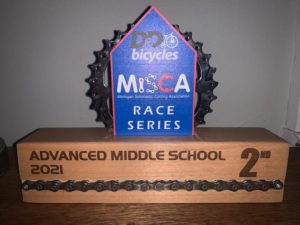 Cannonsburg. I was in a situation where if I didn’t race I would have held the title. If I raced and took 2nd to the 2nd place holder I would lose it. There was never a thought about not racing the final race. Unfortunately, I came in second that day. I was ok with the outcome because I gave everything I had that day and he wanted it just as bad as I did. I’ll be riding in the JV class next year as a Freshman.
Cannonsburg. I was in a situation where if I didn’t race I would have held the title. If I raced and took 2nd to the 2nd place holder I would lose it. There was never a thought about not racing the final race. Unfortunately, I came in second that day. I was ok with the outcome because I gave everything I had that day and he wanted it just as bad as I did. I’ll be riding in the JV class next year as a Freshman. y raced Peak 2 Peak which was a lot of fun also. I have the Lowell gravel race coming up and have been training on the gravel. Lately I’ve been meeting up with fellow teammate Collin Snyder for a weekly group gravel ride. This is for getting ready for my first Iceman.
y raced Peak 2 Peak which was a lot of fun also. I have the Lowell gravel race coming up and have been training on the gravel. Lately I’ve been meeting up with fellow teammate Collin Snyder for a weekly group gravel ride. This is for getting ready for my first Iceman.












